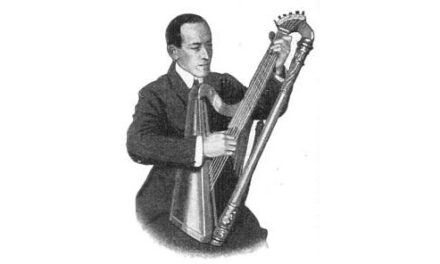A couple months back, this beautiful c.1895 cabinet card sold on eBay (for a record price). I was sorry not to get it, mainly because I was hoping for a better scan; this one is frustratingly blurry.
I did ask the seller about the white rectangle inlay in the last fret, and they assured me that they couldn’t resolve if any lettering was there. This is of course where we expect to see the Jenkins Company’s “HARWOOD” brand engraved in the bone or celluloid. This engraving is usually difficult to see in historical photographs, so the white rectangle itself is how we usually identify (attribute) Harwood mandolins, guitars and harp guitars when such inlays appear in photographs.
I was especially excited to see this attributed Harwood, as it represents a new model. As it turns out, it appears to be a third example (the first clearly shown) of yet another one of Jenkins’ early, semi-standard non-catalog models. I noticed that it seemed to closely match another suspected Harwood in a photo I’ve had on the site awhile. In fact, with more to go on, I soon found a third photo on my “Unidentified American” harp guitar Iconography page that seemed now to be the same Harwood model.
All three photos are now added to the Harwood page, as are the new individual harp guitars, which are additionally discussed and compared side by side (as seen below).

Oh, and I cataloged another Harwood HG specimen – however it’s one neck shy (what a waste!).


I also added to the page this rare and unique woodcut (kindly donated by Robert Jenkins, himself) from an 1898 Kansas City Journal. It shows the building of three of the double-soundhole harp guitars…perhaps one of them is even mine!?

P.S: I have one more piece of Harwood news I just discovered, and it’s major. It’s worthy of a separate blog – but first I’ve got to wrap my head around the implications of it.







Can’t wait!